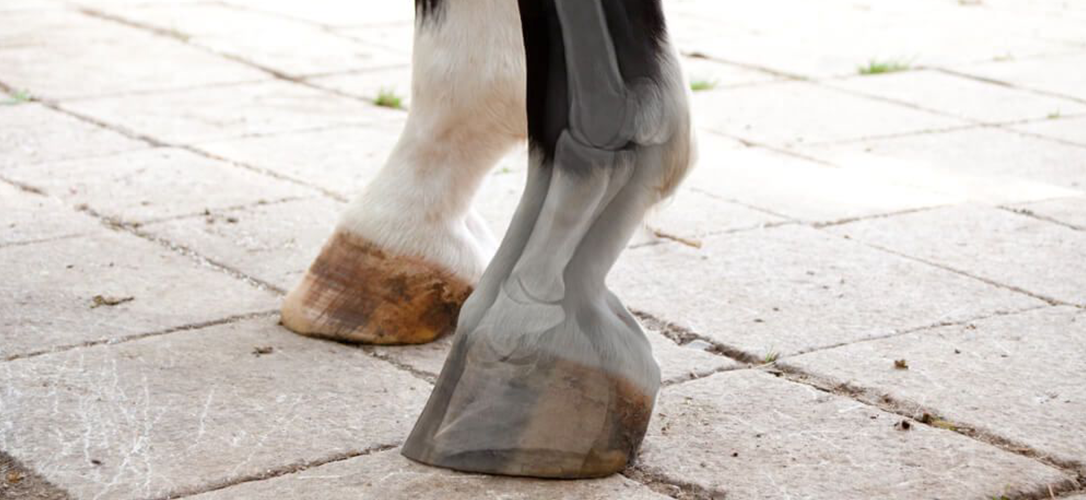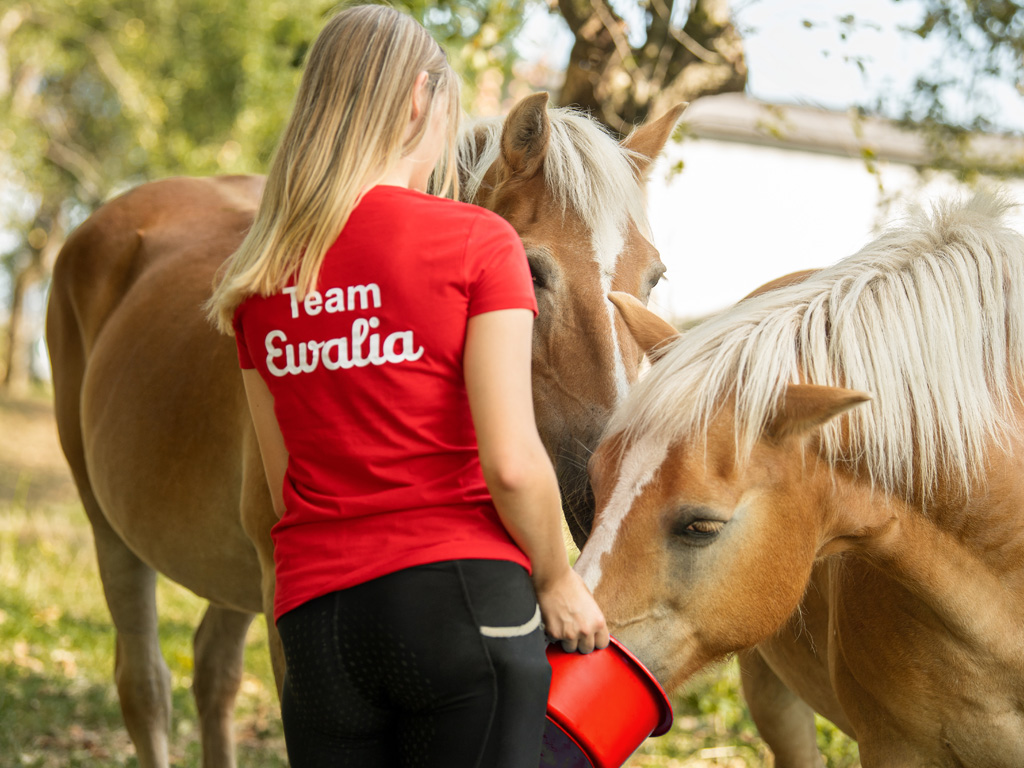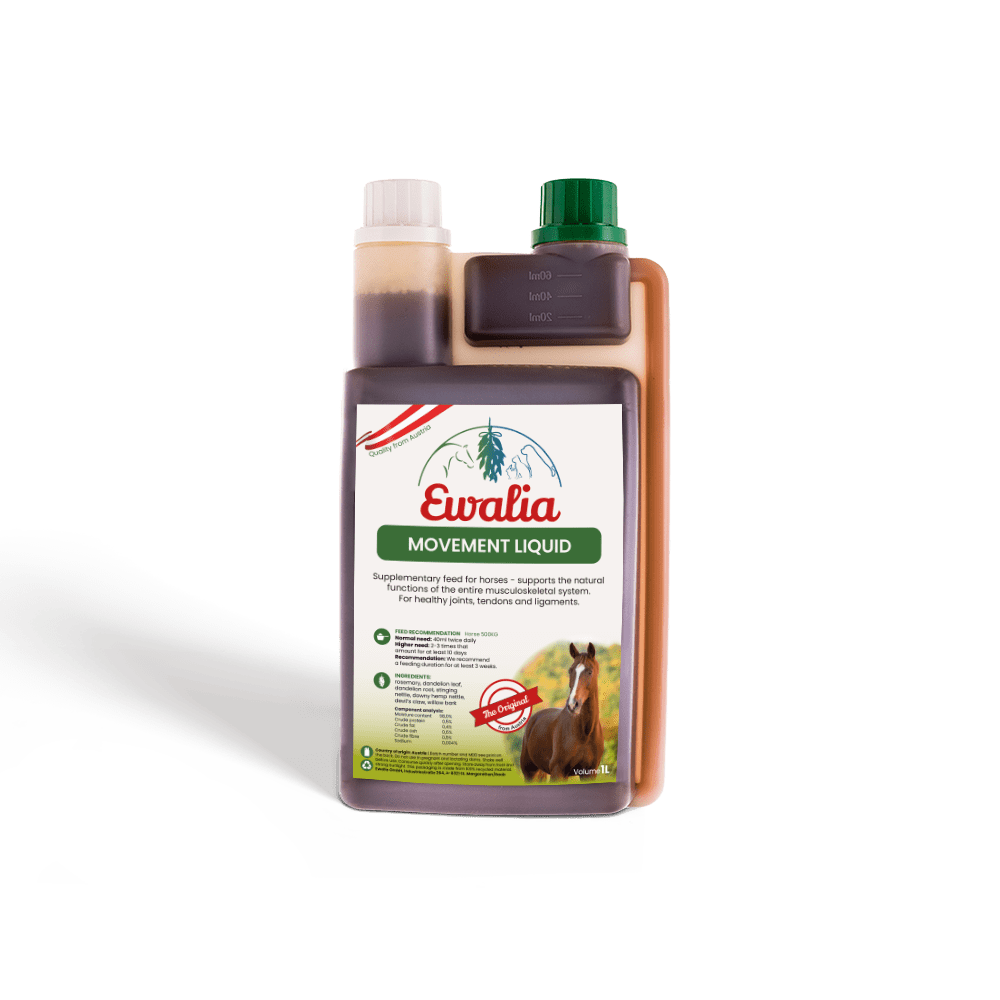Help for equine osteoarthritis?

A dreaded, irreversible and incurable disease: a diagnosis of osteoarthritis often signals the end of a sport or leisure horse's career. Are there ways to slow the progress of osteoarthritis? How to relieve pain and stiffness in your horse with chronic joint disease and which herbs are recommended for horses with osteoarthritis.
What is osteoarthritis?
Osteoarthritis is a disease characterised by signs of degeneration in joint cartilage and bone structure. It is a cause of chronic lameness in horses due to the pain associated with the breakdown of articular cartilage and stiffening of the affected joint. Recent estimates suggest that 60% of all cases of lameness in horses are related to osteoarthritic processes. Osteoarthritis can affect any joints, but it is mostly seen in the hock (bone spavin), fetlock (ringbone) and knee joints.
How does a healthy equine joint function?
Our horse's joints must withstand enormous strain. Over decades they are stretched, flexed and extended, thousands of times a day. They bear the weight of both the horse and rider and absorb shocks.
A joint is a complexly constructed, movable connection between two bones that is stabilised by a joint capsule and collateral ligaments. The space between the bones is filled with synovial fluid, which is regulated by the synovial membranes and provides lubricants and nutrients to the articular cartilage that covers and cushions the bone ends. The mechanism of production and resorption of synovial fluid causes the joint to be cleansed of abrasion products.
Articular cartilage has an especially important role: It reduces rubbing in the joint, keeps it moveable and protects it from overstress and abrasion. Articular cartilage tissue consists of collagen fibres, a robust protein in the connective tissue which gives the cartilage tissue its stability. The collagens are intertwined with proteoglycans that can absorb fluid and strengthen the tissue. When the joint is flexed, the cartilage stretches and compresses, providing circulation of fluid in the spaces between the joints. Cartilage can be compared to a sponge: it absorbs liquid when the pressure to the joint subsides, and presses it out again when the pressure builds, thus acting as a shock absorber.
What happens with osteoarthritis?
Stresses from impacts or overextension often cause tiny lesions within the joint. These small injuries are "repaired" through slight inflammatory reactions in the joint. A healthy horse's own natural defences are normally able to keep these inflammatory processes under control so that the joint heals and remains mobile.
If the body is no longer able to control the inflammation, the synovial fluid is broken down and diluted by enzymes released in the inflammatory process. This results in a chain reaction: the collagen layer is not sufficiently maintained. The cartilage loses its ability to absorb and release fluid. This in turn triggers more inflammatory reactions. The joint capsule fills with fluid, leading to pressure, pain and stiffness and, most importantly, further inflammation, causing further breakdown of the synovial fluid and progressive damage to the cartilage tissue. The cartilage loses its elasticity, its surface becomes rough and frictional resistance increases. The collagen fibres can tear and the cartilage can completely disintegrate, causing the underlying bone ends to rub against each other and erode. This leads to the formation of bone spurs that stiffen the joint.

How does osteoarthritis occur?
- Osteoarthritis is often a result of joint inflammations that have not healed, such as those that occur after injuries.
- Misalignments of the limbs and/or hooves increase a horse's risk of developing osteoarthritis.
- Too early and too much strain on the horse increases the risk of chronic joint diseases.
However, wear and tear of joint cartilage is also a normal sign of ageing in many horses aged 18 and older.
What are the symptoms of equine osteoarthritis?
Osteoarthritis develops gradually and is not easy to detect in its early stages. An affected joint will sometimes be quite warm and swollen. Some horses show early signs of osteoarthritis like stiff movements or short gaits. Others may refuse to be lunged in one direction, or they don't want to trot or gallop. Others might refuse to accept the rider's aids and become resistant. It is typical for symptoms to subside as soon as the horse has warmed up a bit through movement.
If osteoarthritis is suspected, a vet should be brought in to examine the horse. A comprehensive lameness exam, flexion tests and X-rays can determine which joint is affected. Osteoarthritis cannot be reversed, but If detected early, it can at least be slowed.
Can osteoarthritis be prevented?
- A horse with musculoskeletal injuries should be thoroughly checked over by a vet, because small traumas can lead to join inflammations which in turn can lead to osteoarthritis.
- Cold starts and fast gaits on too-hard surfaces can cause microlesions in joint areas.
- Excess weight puts strain on the joints.
- Regular hoof care minimises the risk of uneven pressure on the joints.
How can I best help a horse with osteoarthritis?
Aside from pain-relieving medications which may be necessary for acute relapses, there are a number of ways to help arthritic horses to enjoy easier movement and more quality of life.
Exercise
Moderate exercise helps keep joints fit. Light work – always within the horse's comfort zone – strengthens muscles and ligaments, helping to stabilise joints, and stimulates the production of synovial fluid. In addition, many horses don't take to a sudden "retirement" well, and will enjoy leisurely rides with a buddy or long walks in hand.
Caution: Avoid steep hills and surfaces that are too hard or too soft!
Some horses get all the exercise they need during turnout. The slow movement of grazing is ideal for horses with osteoarthritis, however you should keep an eye on herd dynamics. An arthritic horse will feel better with it is able to move at its own tempo in a group of calm, laid-back horses, without being chased around or enticed to run about wildly.
Feeding
When a horse begins to exercise less, this reduced energy consumption should be considered when measuring its feed ration in order to avoid excess weight and associated additional stress on the joints.
Physical therapy
If the joint is causing pain, the horse will adopt a protective posture that affects the muscles, ligaments, tendons and other joints. Manual therapy can prevent the occurrence of secondary symptoms of osteoarthritis.
Feed supplements for cartilage development
There are several feed supplements that can promote equine joint health. Most contain glucosamine, chondroitin sulphate and/or hyaluronan (hyaluronic acid) – three substances that are also found in the joints. Glucosamine promotes cartilage formation and regeneration, chondroitin sulphate keeps cartilage elastic, and hyaluronan helps lubricate the joints. Avocado-soybean extract (ASU) can also be used as an alternative or supplement to glucosamine.
Glucosamines are said to work better when they are taken in combination with omega-3 fatty acids, which are found in linseed oil and microalgae, among other products.
MSM (methylsulphonylmethane) is a white, odourless, crystalline substance which is 34% sulphur. Sulphur is a central component of the body, has anti-inflammatory and antioxidant effects and can stimulate bone metabolism. MSM can be used alone or in combination with other anti-arthritic preparations.
Herbs for horses with osteoarthritis
Conventional pain relievers like Phenylbutazone and NSAIDs provide temporary relief to the horse but should not be administered long-term, because they will impair the horse's metabolism and especially its gastric mucosa. Ginger is often recommended for reducing inflammation and cartilage deterioration, but can cause gastrointestinal ailments in high concentrations. The following medicinal herbs are good alternatives for providing subsequent relief to the organism after the use of medications.
Rosemary
Rosemary (Salvia rosmarinus/ Rosmarinus officinalis) has a long history as a medicinal herb. When taken internally, it improves liver and bile function and stimulates digestion. It is also medically recognised for supportive therapy for spasmodic gastrointestinal and non-specific dyspeptic complaints. Used externally, rosemary promotes blood circulation and is used for supportive therapy for muscle and joint complains as well as for rheumatic diseases and circulation problems. Rosemary oil is applied locally as a mild antiseptic to promote the healing of wounds. Caution: Do not use rosemary on animals with gallstones or obstructed bile ducts. Because it increases bile flow when taken internally, it may trigger colic. Horses do not have gall bladders, but this should be kept in mind for humans and other animals that do. Furthermore, rosemary oil should not be used in baths for patients with major skin injuries, fever, or cardiovascular diseases.
Dandelion
Dandelion (Taraxacum officinale) is a true multi-talent. Recognised as a traditional medicinal plant by the HMPC (Herbal Medicinal Product Committee), it is used for supportive treatment of rheumatic or dyspeptic complaints, to improve liver and bile function, improve urine flow and increase urine output, and to aid in the prevention of kidney stones. Dandelion’s metabolism-stimulating effects make it a popular component of many springtime cures. It is beneficial to connective tissue, promoting the elimination of metabolic waste products and therefore beneficial to the healing processes from rheumatic diseases and gout. Dandelion’s antioxidant properties are also being extensively researched in cancer therapy.
Common nettle
Common nettle (Urtica dioica) is also recognised as a traditional healing herb. The Commission E recommends nettle leaves for flushing of the urinary tract and for kidney stones prevention as well as in supportive therapy for rheumatic complaints and inflammatory diseases. ESCOP (the European Scientific Cooperative on Phytotherapy) also recommends the use of nettle to treat osteoarthritis and arthritis as well as for better water elimination. The entire herb and roots are used. Caution: Do not perform flushing therapy if oedema is present due to impaired cardio-renal function. Do not use in combination with synthetic diuretics.
Common hemp nettle
Common hemp nettle (Galeopsis tetrahit) is used in folk medicine as an astringent, mucolytic, and anti-inflammatory as well as to purify and build blood. In addition to flavonoids, resins and tannins, hemp nettle also contains iridoids – especially harpagoside, which is also found in devil's claw. It also contains essential oils and saponins and is rich in silicic acid. Silicic acid supports connective tissue formation and is important for building skin, hair, and cartilage tissue.
Devil’s claw
Devil’s claw (Harpagophytum procumbens) is a traditional healing herb. It is used to treat osteoarthritis symptoms and back pain, and in supportive therapy for degenerative joint diseases. Its effectiveness is due to the iridoid glycosides it contains, especially harpagoside. This water-soluble substance is known for its analgesic and anti-inflammatory effects. Other plants that contain harpagoside include mullein and hemp-nettle.
Willow bark
Willow bark (Salicis cortex) is the bark of various species of the genus Salix, with the species Salix purpurea, Salix fragilis and Salix daphnoides primarily used in medicine. Willow bark extracts are recognised by the HMPC as medicinal substances. ESCOP recommends willow bark for treating back pain, rheumatic complaints, fever from the common cold, and headache. Its active substance is salicylate. Acetylsalicylic acid is commonly known worldwide as aspirin. It is used for its anti-inflammatory, analgesic and blood-thinning properties.
Meadowsweet
Meadowsweet (Filipendula ulmaria/ Spiraea ulmaria) belongs to the genus Spiraea and originally gave aspirin its name. Meadowsweet contains flavonoids and tannins and, like willow bark, it is rich in salicylates. The HMPC recognises meadowsweet as a traditional medicinal plant. Due to its anti-inflammatory, analgesic, and blood-thinning properties, meadowsweet is used to treat symptoms of the common cold, including rheumatic pains.
It is also used in folk medicine for rheumatic diseases, muscle and joint ailments, to promote water elimination, and for non-specific pains. As with willow bark, do not use meadowsweet if taking blood-thinning medication. Do not use meadowsweet in the case of hypersensitivity to salicylates.
Rose hips
Rose hips (Rosae fructus) are the fruits of various rose species like the dog rose (Rosa canina) or the apothecary's rose (Rosa gallica). Rose hips are rich in ascorbic acid, tannins, pectin, sugar, flavonoids, and fruit acids. ESCOP recommends rose hips for treating the common cold and flu and to relieve pain and stiffness associated with osteoarthritis. In folk medicine, they are also used to treat bladder and kidney problems, rheumatic diseases, and gout. Rosehip seed powder, due to its anti-inflammatory and antioxidant efficacy, is a popular food supplement for rebuilding cartilage tissue lost from osteoarthritis. Taken regularly, it counteracts inflammatory processes and increases joint mobility.
Turmeric
Turmeric (Curcuma longa) is a traditional medicinal plant. Turmeric has been used in Ayurvedic medicine for 4,000 years. It was once known as “Indian saffron” because of its yellow roots. It is a hot spice and is said to have cleansing, energising and anti-inflammatory effects. Turmeric is being studied extensively in ongoing research on its choleretic, antioxidant, anti-inflammatory, analgesic, antispasmodic, cholesterol-lowering, antimicrobial, immunomodulatory, antiproliferative (cell growth inhibiting) and antitumoural properties. It is medically recognised for treating digestive complaints, bile disorders, and dyspeptic complaints. Due to its multiple effects, however, turmeric has the potential to be used for other diseases, such as in the treatment of osteoarthritis, Alzheimer's disease, multiple sclerosis, arthritis, allergic reactions, psoriasis, inflammatory bowel disease, cardiovascular disease, cancer, and diabetes.
Ginger
Ginger (Zingiber officinale) is a traditional medicinal plant. The HMPC recognises its uses to treat seasickness, nausea, and vomiting. Ginger can also relieve gastrointestinal symptoms and bloating as well as provide general digestive support. In folk medicine, ginger and its preparations are used to treat cold and flu symptoms, nausea, seasickness, and digestive complaints. Studies have demonstrated ginger to have anti-inflammatory, anti-flatulent, digestive, analgesic, antimicrobial, spasmolytic, anti-emetic, anti-diabetic, antioxidant and antitumoural properties. Ginger has long been a component of Ayurvedic and traditional Chinese medicines. In western medicine it is used for rheumatic complaints, muscle pain, and colds. Ginger can be used fresh as well as dried and ground. It is used to treat equine inflammations and osteoarthritis due to its anti-inflammatory and metabolism-promoting effects. The German society "NHV Theophrastus" awarded ginger the title of Medicinal Plant of the Year in 2018. Studies have shown it to have antioxidant and cell-protecting functions. It has also been shown to have antitumoural and cancer-inhibiting properties.
Frankincense
Frankincense (Boswellia) is recommended by the ESCOP for treating painful joint arthritis and the symptoms of inflammatory bowel disease. In Ayurvedic medicine, frankincense has been used to treat arthritis, rheumatic diseases, and muscle and joint complaints for thousands of years. The anti-inflammatory active substance AKBA (acetyl-11-keto-beta-boswellic acid) was isolated in 1991 by the German pharmacologist Hermann Ammon. Another substance found in frankincense is incensole. It is alleged to have antidepressant and anxiolytic effects following experiments in animal models. Antidepressant effects in the human brain have not yet been proven.
These and other medicinal plants – including juniper, which promotes blood circulation, and resin-rich pines – can provide relief from inflammatory diseases of the musculoskeletal system and thus considerably improve the quality of life for humans and animals. Always consult with a specialist on the use of these herbs, as it is important that they be used in a coordinated manner for optimum effectiveness.
Sources and further reading
- Brendieck-Worm, C., & Melzig, M. F. (2018). Phytotherapie in der Tiermedizin. Stuttgart: Georg Thieme Verlag KG.
- Meszoly, J. (Oktober 2020). Equus Magazine. Von https://equusmagazine.com/lameness/coping-with-arthritis-in-horses-8356 abgerufen
- Oke, S. (Dezember 2020). theHorse.com. Von Equine Arthritis: https://thehorse.com/wp-content/uploads/2018/04/equine-arthritis-factsheet.pdf abgerufen
- Reichling, J., Gachnian-Mirtscheva, R., Frater-Schröder, M., Di Carlo, A., & Widmaier, W. (2008). Heilpflanzenkunde für die Veterinärpraxis. Berlin-Heidelberg: Springer Medizin Verlag.
- vetepedia. (Dezember 2020). Von Gesundheitsthemen: https://www.vetepedia.de/gesundheitsthemen/pferd/bewegungsapparat/arthrose/ abgerufen
- https://www.apotheken-umschau.de/krankheiten-symptome/gelenks-und-knochenerkrankungen/arthrose-gelenkverschleiss-aufhalten-und-behandeln-736915.html
- https://www.medizin-transparent.at/teufelskralle-arthrose/
- https://www.medizin-transparent.at/neues-im-kampf-gegen-arthrose/
- https://www.tiermedizinportal.de/tierkrankheiten/pferdekrankheiten/arthrose-gelenkverschleis-beim-pferd/
- https://www.pferderevue.at/magazin/gesundheit_medizin/2017/11/schmerzhafte_winterzeitwaspferdenmitarthrosejetztguttut.html
- https://arzneipflanzenlexikon.info/
- https://www.deutsche-apotheker-zeitung.de/daz-az/2006/daz-24-2006/uid-16041
- https://www.andi-und-alex.at/curcuma-curcuma-longa/
- https://www.andi-und-alex.at/ingwer-zingiber-officinale/














